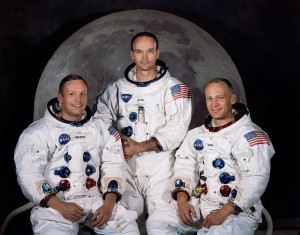
Published on July 20, 2012
“The Eagle has landed.”
At 9:32 am EDT on July 16, 1969, the three man Apollo 11 space craft successfully lifted off from Launch Complex 39A at Kennedy Space Center. Their destination: the Earth’s moon. Four days later on this day in aviation history, July 20, 1969, Neil Armstrong and Buzz Aldrin piloted the Lunar Module “Eagle” toward on the Moon’s surface. It would not be an easy landing.
As the Lunar Module (LM) made its final descent, Armstrong realized that the computers were showing a landing point on the slope of a rocky crater — if he didn’t take over and hand fly the LM, they would likely crash on landing. Running desperately low on fuel, Armstrong was cool and calm on the controls. Gingerly, he slowed the spacecraft’s descent using nearly the last of the rocket fuel. He was able to land safely at 4:18 pm EDT. It was a landing that they had practiced hundreds of times before in the simulator, but nobody knew how would be go on the Moon itself. Mission Control broke into applause when Armstrong reported: “Houston, Tranquility Base here. The Eagle has landed.”
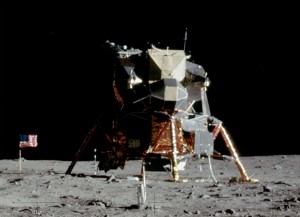
Live news coverage of the events was carried worldwide. It seemed everyone breathed a sign of relief. In a mission on which Armstrong himself put a 50 percent chance of success, it seemed like the impossible had been achieved. Kennedy’s promise of putting a man on the moon within the decade had been fulfilled. It had taken tens of thousands of engineers and workers spanning the entire nation and a budget that was staggering, but man had done what countless previous generations had just dreamed.
While Neil Armstrong and Buzz Aldrin prepared for their historic moon walk, Mike Collins orbited 60 nautical miles overhead in the Command Module that would later link back with the Lunar Module and take them all back home.
The original schedule called for the astronauts to rest first before making their historic climb down the ladder to the Moon’s surface, but neither astronaut was willing to wait. With NASA Mission Control approval, the hatch was opened at 9:30 pm Houston time. Neil Armstrong carefully made his way out and onto the ladder. Over the radio, as live television pictures were beamed back to Earth, Armstrong meticulously described his surroundings with every step down the ladder.
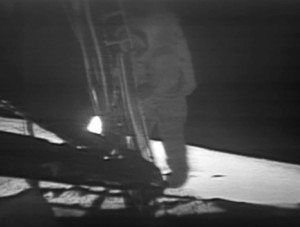
By 9:56 pm, he had finally made his way to the bottom of the ladder to make his most memorable and monumental step onto the surface of the moon. With a last drop from ladder to lunar soil, Armstrong reported: “That’s one small step for man, one giant leap for mankind.”
In 2012, in a rare interview (with an Australian accountant), Armstrong stated that he thought to say those words while en route to the Moon.
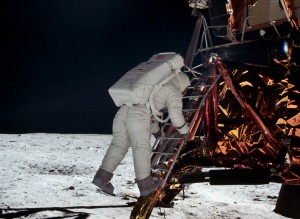
After just over two hours on the Moon’s surface, Houston ordered Armstrong and Aldrin back to the LM at 12:11 am. Like two young brothers called in from a fun-filled day that they wished would never end, the two astronauts collected their rock samples and boarded their craft. Nearby, they had planted an American flag, symbolizing not the “conquering” of the Moon by the United States, but that, as Americans, they “came in peace for all mankind.”
Rocketing off the moon’s surface in the LM, the blast from the liftoff damaged the flag, leading later astronauts to joke that Armstrong may have been first, but he didn’t know how to properly plant a flag to leave behind. In the hours that followed after the LM departed the lunar surface, Armstrong and Aldrin linked back with Collins in the Command Module as the two craft orbited the Moon. Once together, they steered the craft back for their trip back to Earth. They completed their mission with a safe splash down in the Pacific Ocean on July 24.
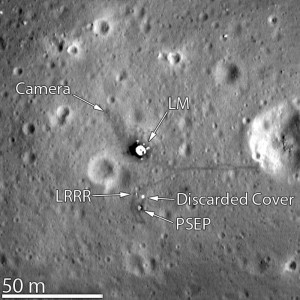
It had been only eight years since John F. Kennedy’s famous speech in which he set forth the challenge and goal of sending a man to the moon. The dream of mankind, a dream that had been unspoken and viewed as impossible just a generation before, had been fulfilled.
One More Bit of Aviation History
Just a few hours before the Apollo spacecraft launched to the Moon, another spacecraft would also launch — the Soviet Union’s own unmanned lunar lander, the Luna 15, which was designed to land on the Moon’s surface and return with rock samples. The Luna 15 was the Soviet’s best attempt at upstaging the American Apollo program in the Space Race. While Apollo 11 landed on July 20, the Luna 15 craft was scheduled to land on July 21. As it worked out, whereas Apollo 11’s LM had Armstrong on board to fly over the ridge of a looming crater, the Luna 15 was unmanned — it crashed into a ridge line in the Sea of Crises area on the Moon’s surface and all contact was lost. Ultimately, the Soviet Union would never achieve a manned Moon landing, despite a massive investment of resources and national prestige. In the Space Race, there would be only one winner.

Cool, even if it was staged.